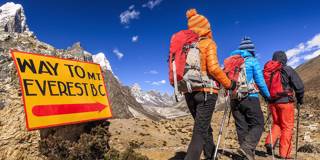Recent images of long lines at the Mount Everest base camp, and at choke points on the way to the summit, offer a perfect real-world example of mismanaged supply and demand. As in a number of other economic-policy areas, a combination of price adjustments and regulation offers the only way off the mountain.
LONDON – Like many others, I was shocked by recent images showing the size of the queue that formed in May to scale Mount Everest, the world’s highest peak, from the Nepalese side. The idea that delays caused by overcrowding may be partly to blame for some of the 11 reported deaths on the mountain during this year’s climbing season is horrific to consider.
About a decade ago, my wife and I trudged the path from Lukla, Nepal, toward the Everest Base Camp, so I have some feel for the attraction of such adventures. But, along with the excitement, I remember feeling disappointed at the sheer number of people undertaking the trek. The initial intrigue was gone, and we saw little point in continuing the struggle just to wait in line. We reversed course at the last stop before Base Camp. (For any aspiring trekkers, I would recommend the underappreciated route up to Nepal’s Gokyo Lakes, which was much less crowded, and had equally splendid views.)
Beyond specific conditions such as the narrowness of the trail, Everest’s overcrowding problem is not so different from many other economic and social challenges that policymakers confront, namely an imbalance between supply and demand, and possibly poor regulation. One example, of special concern to me, is the market for antibiotics, which is failing because the development of new drugs is not keeping pace with demand. But more closely related to Everest is the broader challenge of managing tourist hotspots. Around the world, more and more people have joined the middle class, and they (understandably) want to experience the best that the planet has to offer.

LONDON – Like many others, I was shocked by recent images showing the size of the queue that formed in May to scale Mount Everest, the world’s highest peak, from the Nepalese side. The idea that delays caused by overcrowding may be partly to blame for some of the 11 reported deaths on the mountain during this year’s climbing season is horrific to consider.
About a decade ago, my wife and I trudged the path from Lukla, Nepal, toward the Everest Base Camp, so I have some feel for the attraction of such adventures. But, along with the excitement, I remember feeling disappointed at the sheer number of people undertaking the trek. The initial intrigue was gone, and we saw little point in continuing the struggle just to wait in line. We reversed course at the last stop before Base Camp. (For any aspiring trekkers, I would recommend the underappreciated route up to Nepal’s Gokyo Lakes, which was much less crowded, and had equally splendid views.)
Beyond specific conditions such as the narrowness of the trail, Everest’s overcrowding problem is not so different from many other economic and social challenges that policymakers confront, namely an imbalance between supply and demand, and possibly poor regulation. One example, of special concern to me, is the market for antibiotics, which is failing because the development of new drugs is not keeping pace with demand. But more closely related to Everest is the broader challenge of managing tourist hotspots. Around the world, more and more people have joined the middle class, and they (understandably) want to experience the best that the planet has to offer.